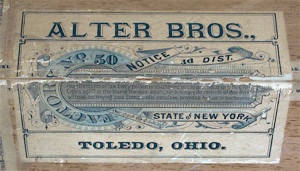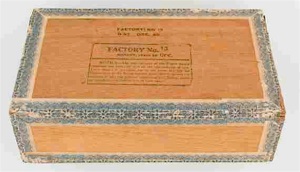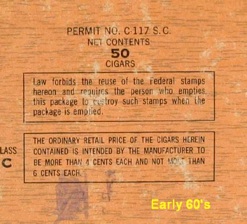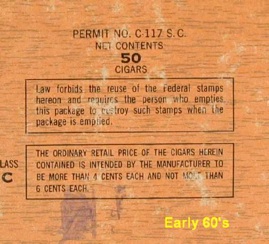Dating Caution Notices
A National Cigar Museum EXCLUSIVE
© Tony Hyman

Dating Caution Notices
A National Cigar Museum EXCLUSIVE
© Tony Hyman
Federal tax laws required all cigar boxes made in the U.S. to have:
[1] tax stamps (1863-1959),
[2] factory I.D.’s (1866-1960’s),
[3] caution notices (1868-1959)
[4] tax class notices (1917-1959)
Caution Notices can be some help in dating.

During the Civil War, the U.S. was divided into 66 tax districts with less than 175 officials given the difficult task of enforcing all tobacco excise tax regulations in the country. In response to reports and complaints from agents, Congress changed tax laws every year. In 1872 they finally set specific size and design rules for Caution Notices and IDs.
Caution Notices were required to contain the Federal Factory number, Tax District and State. The law permitted the Caution Notice to also include the name of the maker or the retailer or wholesaler, a rule that has led to confusion ever since. The CN pictured reads “Alter Bros., Toledo, Ohio” but they are not the maker. The ID printed on both the CN and the box itself Identifies the maker as Factory No. 50 (owned by the Lichtenstein Bros.) one of New York City’s largest cigar factories, producer of 4,500 boxes of cigars daily.
Caution Notices were printed on separate pieces of paper and pasted on boxes until 1910 when the law required they be printed onto the bottom of every box, making it easy to date boxes as before or after 1910. Size was set by law, and you’ll see little variation. The 1880 CN wording remains the same into the mid to late 1950’s.
At some time in the late 1950’s (perhaps as early as 1955) a new CN wording appeared, reflecting a kinder gentler tax office.
“Law forbids the reuse of the federal stamps hereon and requires the person who empties this package to destroy such stamps when the package is emptied.”
U.S. cigar boxes without Caution Notices date after 1960.

CN’s on boxes of cigarette size cigars:
Cigarettes and cigarette size small cigars have CN’s similar, but not identical, to cigars. The CN wording apparently used in the 1880’s:
NOTICE. The manufacturers of the cigarettes herein
contained have complied with all the requirements of the law. Every person is cautioned not to use either this box for cigarettes again, or the stamp thereon again, nor to remove the contents of this box without destroying said stamp, under the penalties provided by law in such cases
Longer wording [left] adds “stamped wrappers upon the packages or parcels” seems to have first appeared in the early 1890’s. When it officially ended is unknown, but it appears as if after 1910 CN’s had the same wording for all cigars. Boxes of 50 and 100 small cigars were seldom sold after packs of 10 and 20 small cigars were allowed by the Act of 1897.
CN’s on boxes of imported foreign cigars:
Caution Notices are also similar but not identical on boxes of cigars imported from countries con-trolled or influenced by US Occupation forces and or other political meddling.
Boxes imported from the Philippines and Puerto Rico have different wordings on their Caution Notices. Not enough is known about the various wordings to make them useful for dating.
The Philippine box is from the early 1930’s.
The Puerto Rican box is from about 1904.

See Dating Canadian Boxes for examples of Caution Notices found on boxes from Canada.
CN’s on boxes of tobacco products:
Caution Notices are also similar but not identical on boxes and cans that contain chewing tobacco, pipe tobacco, snuff or plug. If the word “tobacco” is in the Caution Notice, it’s not a cigar box except in the case of novelty <“jumbo”> cigars which were taxed as tobacco products not cigars.
[11783]
The 1868 wording of a Caution Notice is important because it was not changed until 1880 making it a positive identifier of an 1870’s box.
NOTICE: -- The manufacturer of the cigars herein contained has complied with all the requirements of law. Every person is cautioned under the penalties of law not to use this box for cigars again.
The wording was specified, but not the size, placement, or form. Creativity ran rampant. The wording was printed in tiny type and often incorporated (hidden) in nail seals, end labels, or fake Union Stamps [left].
One of the most audacious cigar makers came up with a caution notice the size, color and general design of the 1868 Import tax stamp used on boxes of Cuban cigars, an attempt to fulfill the law while misleading smokers. The actual Notice is in miniscule type inside the right hand oval.
These odd CN’s are very rare as most of them were destroyed by tax officials once discovered.
NOTICE: -- the manufacturer of the cigars herein contained has complied with all the requirements of law. Every person is cautioned not to use either this box for cigars again or the stamp thereon again, nor
to remove the contents of this box without destroying said stamp under the penalties provided by law in such cases.
Cigar making is a marginal low profit business. Federal Civil War era taxes were outrageous, sometimes more than doubling the price of cigars. It is no surprise that tax evasion was widespread. One strategy was to put the stamp on in such a manner that the box could be emptied and refilled without breaking the stamp. Congress addressed that practice by passing a law in 1868 requiring cigar makers to paste a Caution Notice on every box of cigars. Caution Notices remain on all U.S. cigar boxes until 1959.
Examples of illegal stamp use are seldom found as they were destroyed by tax officials when discovered. This 1868 box is rare in many ways. Inner labels are very scarce on 1860’s boxes, 95% of which have plain paper inners, the cigars are quite small, the label is a copy of a Cuban export brand, and boxes of 50 are almost never found from the 1860’s.
A Curator’s Favorite




Caution Notices







Knowing the early wording is useful when you find a cigar box with an 1878 tax stamp, used between 1878 and 1883. The law ordering a wording change on CNs was passed in 1879 and went into effect in 1880, so you can date boxes with 1878 stamps to the 1870’s if they have a short CN or the 1880’s (and beyond) if they have the longer more comprehensive wording which reads:

Bonus examples of early chicanery

[9029]
